Bedford Square, Bloomsbury must be one of the best preserved, late 18th century squares in London, and in this part of London there is plenty of competition.
Bedford Square is just north of New Oxford Street, and has the British Museum to the east, and Tottenham Court Road a short distance to the west. The following map shows the location of the square in red:

Bedford Square was planned and built between 1775 and 1780 as part of the development of the land owned by the Duke of Bedford (hence the name) within his Bloomsbury Estate.
This was a time when London was expanding northwards and the fields, streams, ponds and footpaths that comprised the Bloomsbury Estate would soon be part of the built city, however it would be a unique area due to the number of large squares which provided open, green space for the occupants of the new houses to enjoy.
The following extract shows the area as it was not long before the development of Bedford Square. This is from Rocque’s map of 1746 and I have marked the future location of Bedford Square with the red rectangle, and much of the approximately 112 acres of the Bloomsbury Estate then open space:
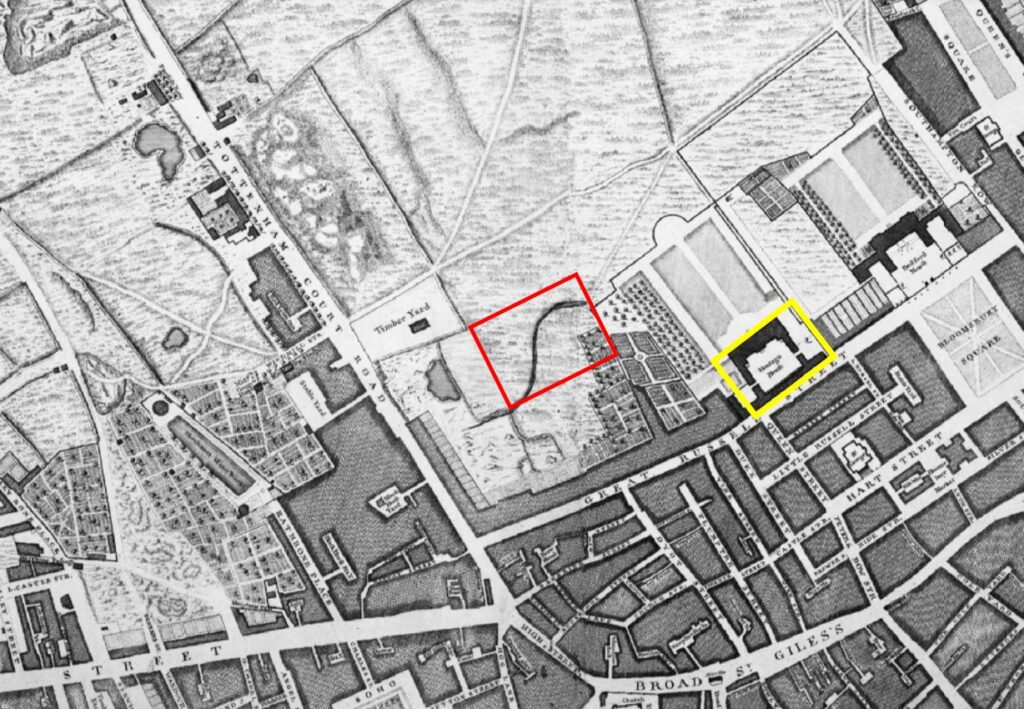
The yellow rectangle is around Montague House, the future site of the British Museum.
Plots of land around Bedford Square were leased by the architect Thomas Leverton and builders, Robert Crews and William Scott.
it is believed that Thomas Leverton was responsible for the overall plan of the buildings lining the four sides of the square, although there is no firm evidence to support this.
Thomas Leverton was the son of the builder Lancelot Leverton who was based in Woodford, Essex.
He seems to have designed a number of country houses, and where there is firm evidence of his connection with Bedford Square is with number 13 where he worked on the interior of the building and lived in the house from 1796 until his death in 1824.
Each of the sides of the square has the same basic design, which was intended to emulate the appearance of a large country house, with the central building decorated with stucco, along with pilasters and pediments.
The “wings” of this central house are the row of brick terrace houses on either side of the central house and that run to the corners of the square:
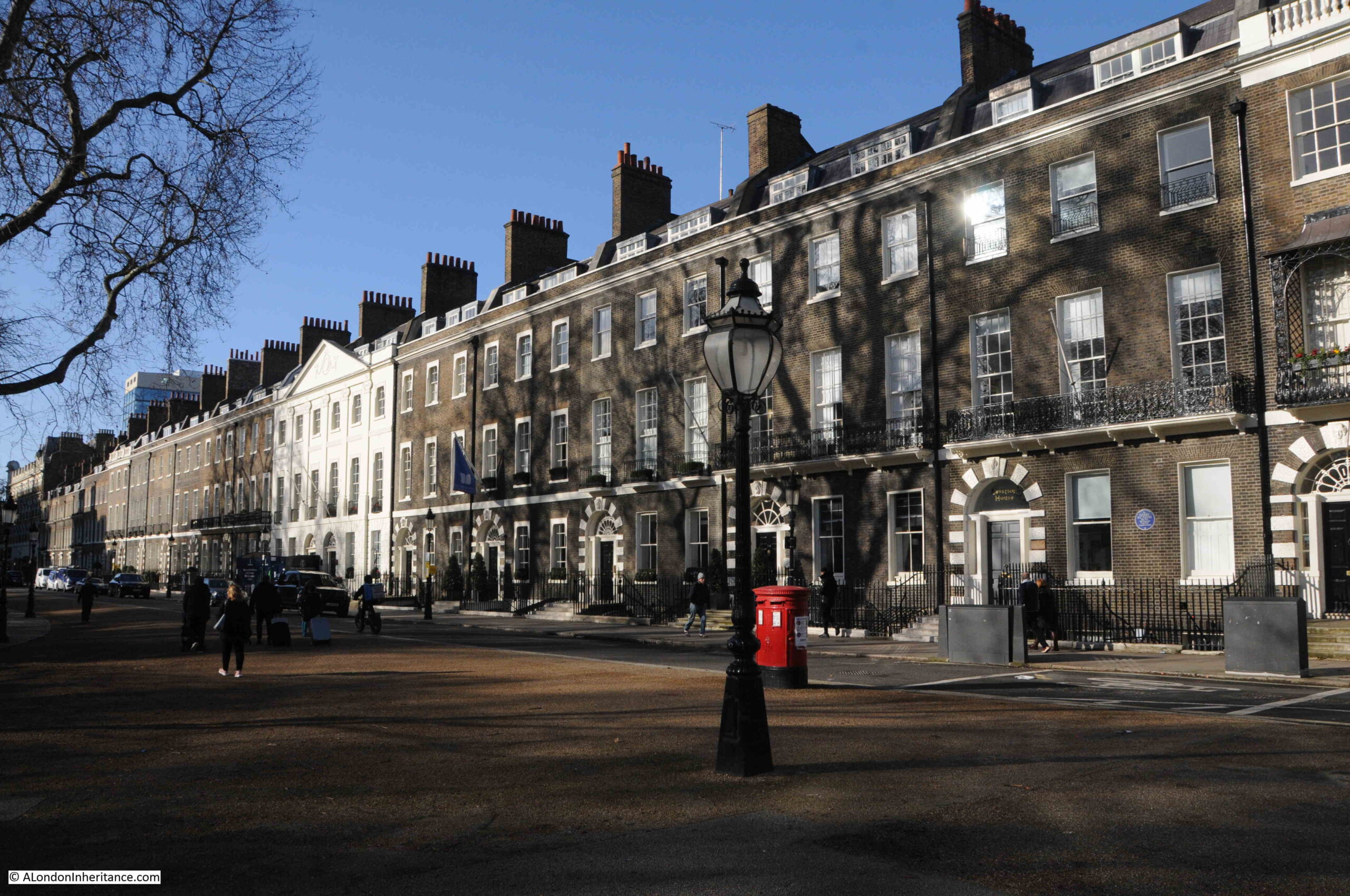
The above photo is of the northern side of the square and the photo below is of the eastern side. The overall design is the same however there are subtle differences, for example the central house on the north side has six bays, whilst that on the eastern side has five:
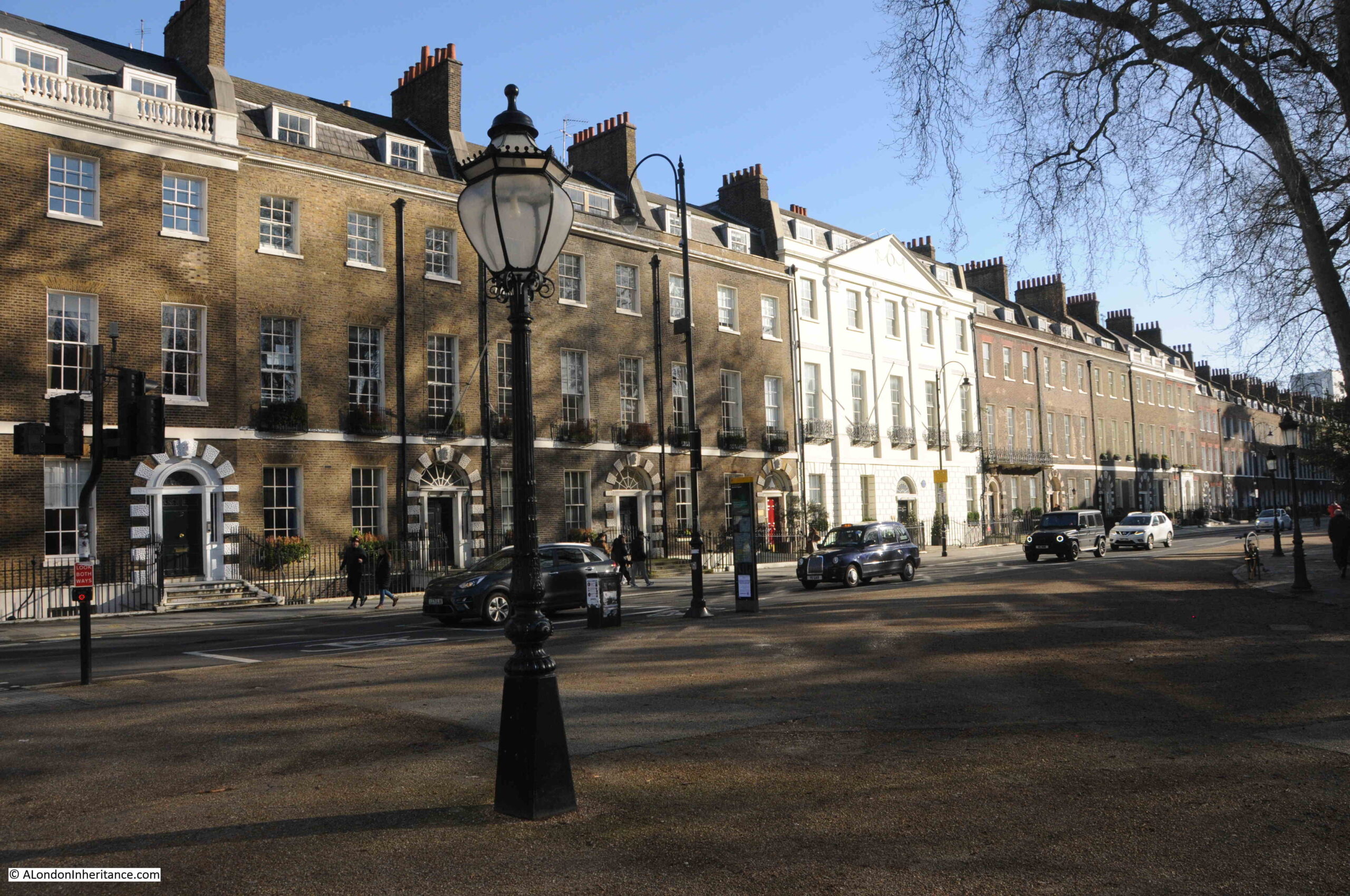
This seems to be down to the fact that the square is not really a square, rather a rectangle with the north and south sides being 520 feet long whilst the east and west are 320 feet.
To show how little Bedford Square has changed, the following print from 1851 is of the same view as the above photo:
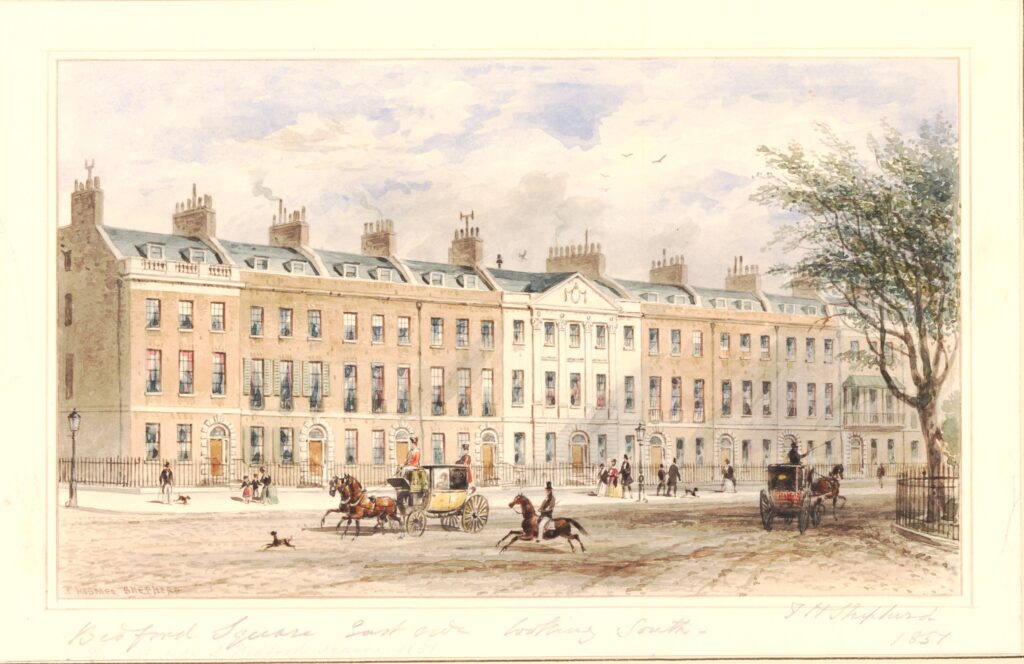
© The Trustees of the British Museum Creative Commons Attribution-NonCommercial-ShareAlike 4.0 International (CC BY-NC-SA 4.0)
The only things that have changed is the replacement of coach and horses by cars, wider paving and the amount of street furniture we see today.
The remarkable preservation of the houses in Bedford Square appears to be due to the way that the Bedford Estate has managed the square since its original construction.
Steen Eiler Rasmussen writing in “London: The Unique City” (1948 edition) gives a fascinating insight into how this worked.
The original land was leased as a number of lots where a house would be built, and for the first 99 year lease, the annual ground rent was £3 for each lot.
After 99 years, the Bedford Estate than became the owner of not only the ground, but also the house that had been built on the land, and it was then leased for an additional period for a new annual sum that reflected both the land and the house, so by the end of the 99 years of the first leasing period, houses were then leased at different values to reflect the type, design and condition of the house on the land.
After the first 99 years, as well as different financial values, the leases were also for different periods, between twenty and fifty years. This seems to have been based on the work that the new leaseholder was planning to put into the building, so a leaseholder making a considerable investment on repairs, rebuilding and improvements would have a longer lease period.
One of the benefits to the Bedford Estate of then having leases expire at different times was that it avoided the risk of the leases for all the houses surrounding the square being renewed, for example, during a period of financial depression and low demand, when lease values would have been reduced.
It also means that any plans for radical change across the square are difficult, as the leases all expire at different times, and so the leases that make up a large block of land would not all become available at the same time.
I have no idea whether the Bedford Estate still takes this approach, however it does help explain why the houses in Bedford Square have externally hardly changed since their original build.
Although the external appearance has hardly changed, the interior of the houses on Bedford Square may be very different, reflecting the changes that have taken place over the last few centuries. Different uses, different types of owner, all would have left their mark on the interior.
There are also subtle different to the external façade of the houses, for example, this end of terrace house has a metal veranda structure above the balcony that runs the full width of the house:
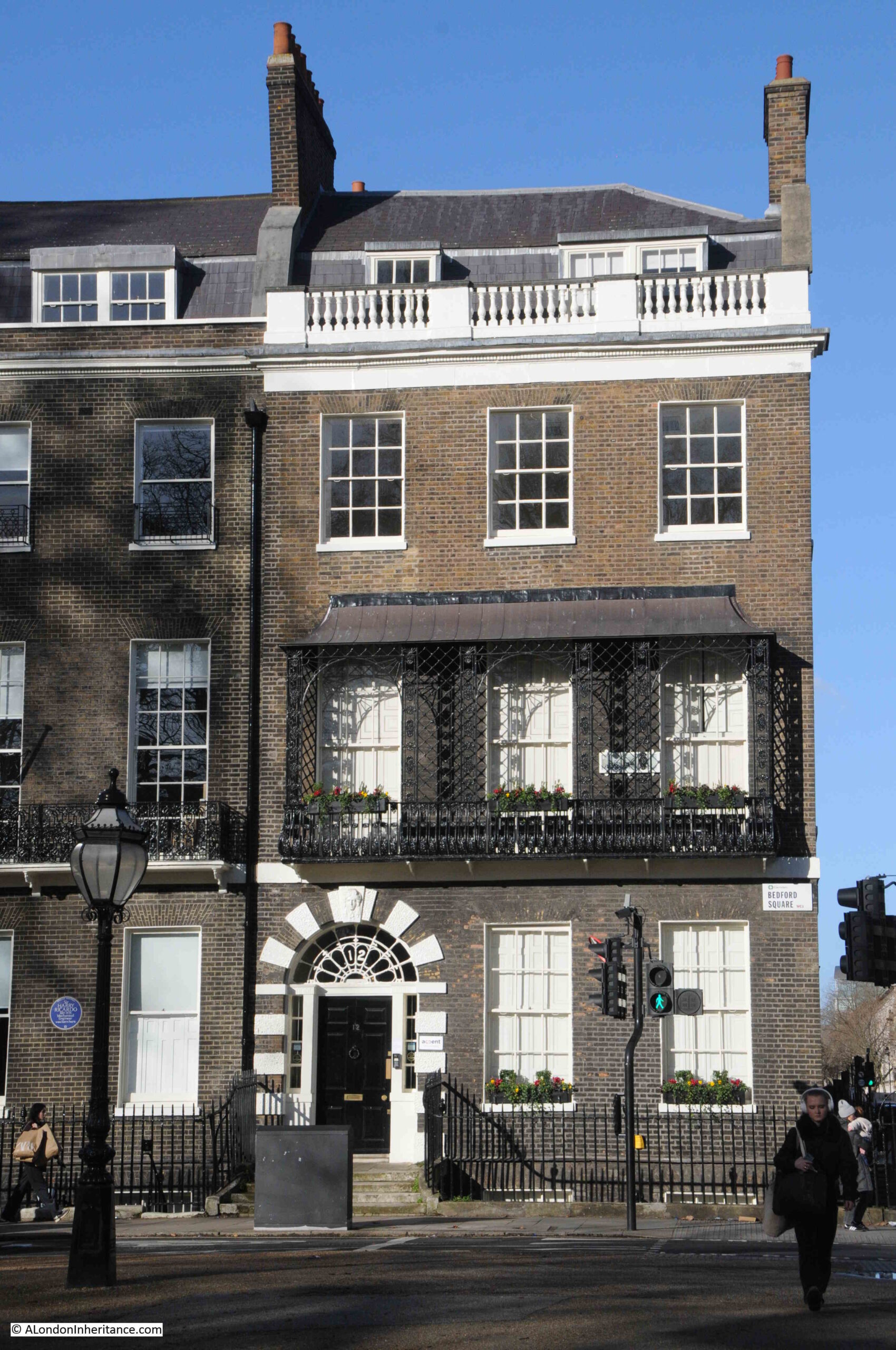
From the street, these houses look relatively narrow, however clever design results in a sizeable interior.
The following plan from the book London: The Unique City shows the layout of a typical house in Bedford Square:
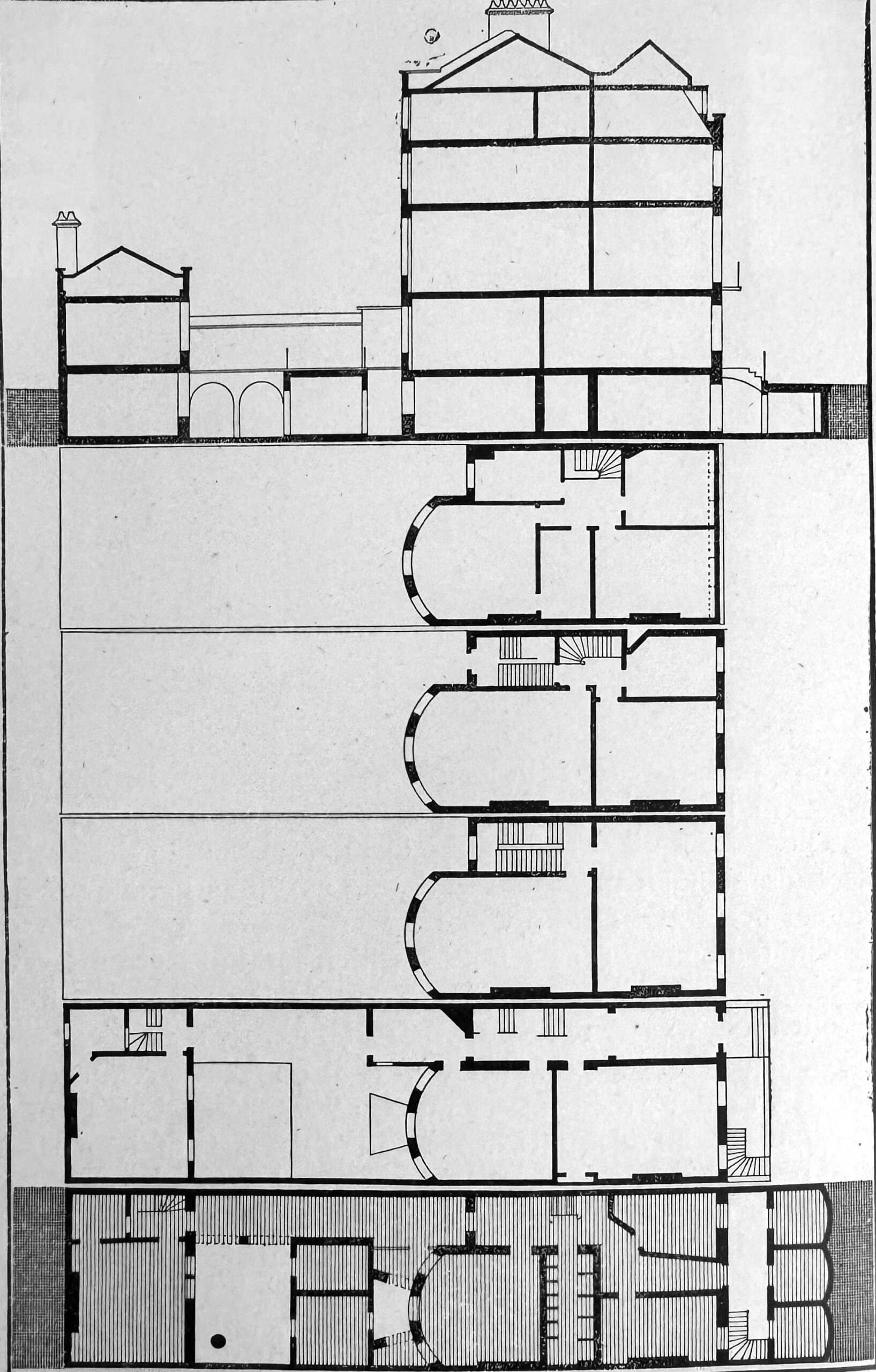
Despite the narrow front facing onto the square, each house does extend a fair way back, with both the basement and the ground floors extending some distance, and storage areas which would have held consumables such as coal, extending underneath the pavement from the basement.
On the north east corner of Bedford Square, the house in the photo below has street signs indicating that it is at the corner of Gower Street and Montague Place:
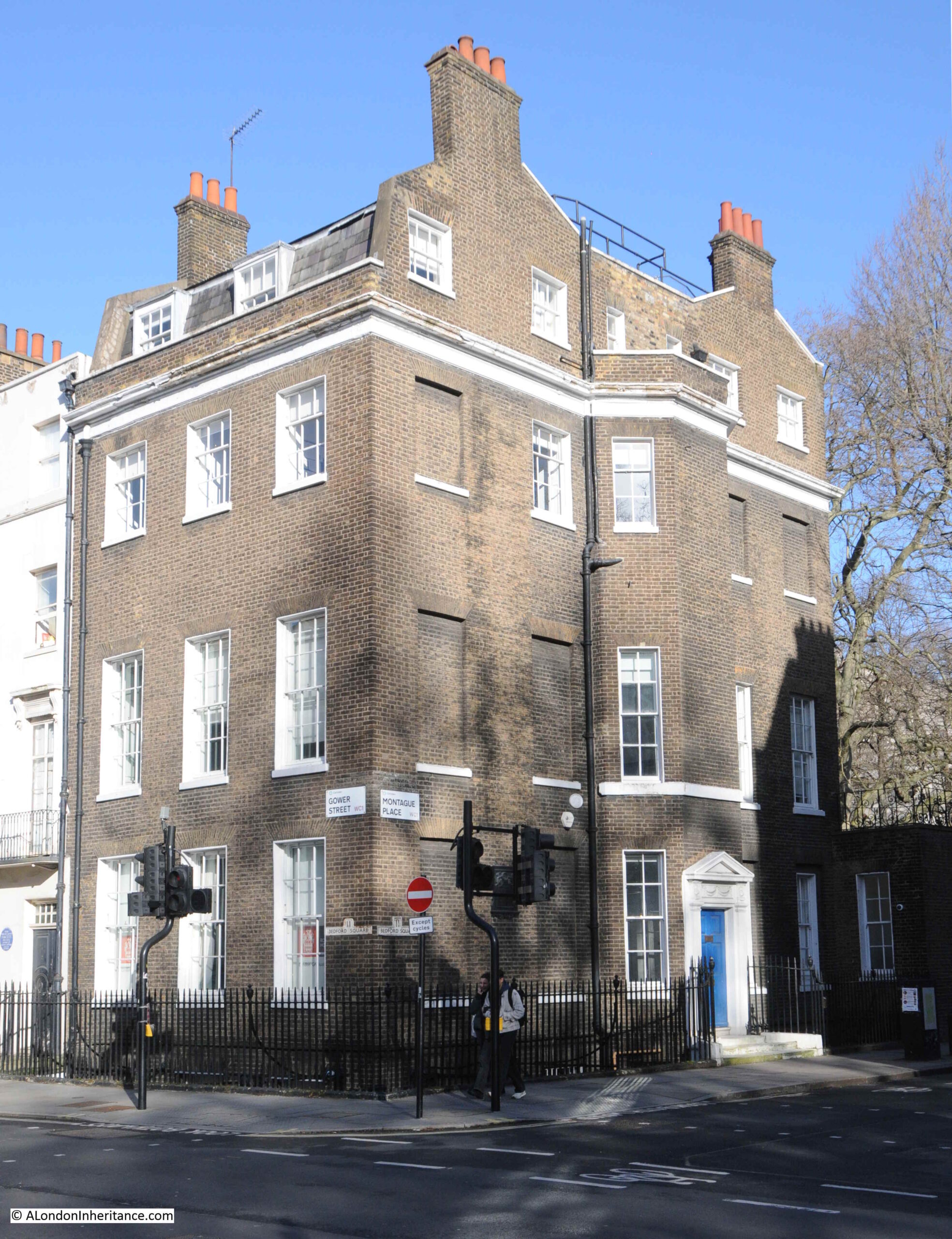
However below the signs for these two streets are these much older signs indicating a Bedford Square address:
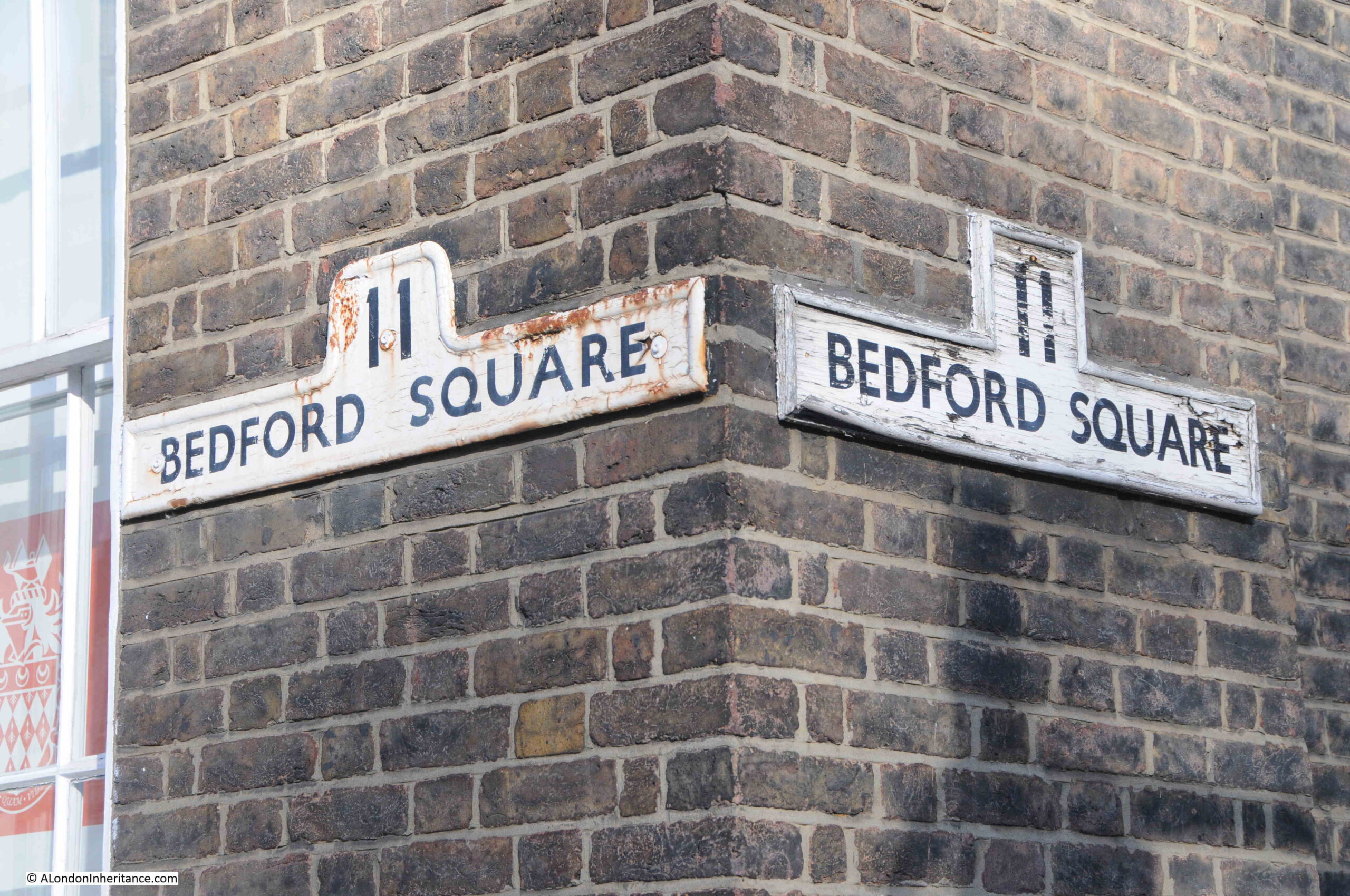
Much of the decoration around the doors of the houses is of Coade Stone, which was made in the factory owned by Eleanor Coade on the south bank of the river, just to the west of the Royal Festival Hall, and in the following photo Coade stone alternates with brick around the main entrances to the house:

As could probably be expected for a location such as Bedford Square, there are a large number of blue plaques on the houses. On the house in the above photo is an English Heritage plaque to Sir Harry Ricardo:

As stated on the plaque, Sir Harry Ricardo was a Mechanical Engineer, and much of his work was centred around the development of the internal combustion engine for both vehicles and aircraft, and his work contributed to the outcome of the First World War as he developed the engines that were used by the tanks on the battlefield.
And if you fill up a car with petrol, and check the octane rating of the petrol, that is also down to Sir Harry Ricardo as his work on the chemical composition of fuels resulted in the octane classification system
The company he founded is still going strong, and is still named Ricardo, and is based at Shoreham-by-Sea in West Sussex.
The large central houses on the north and south sides of the square have six window bays, and two large entrances:
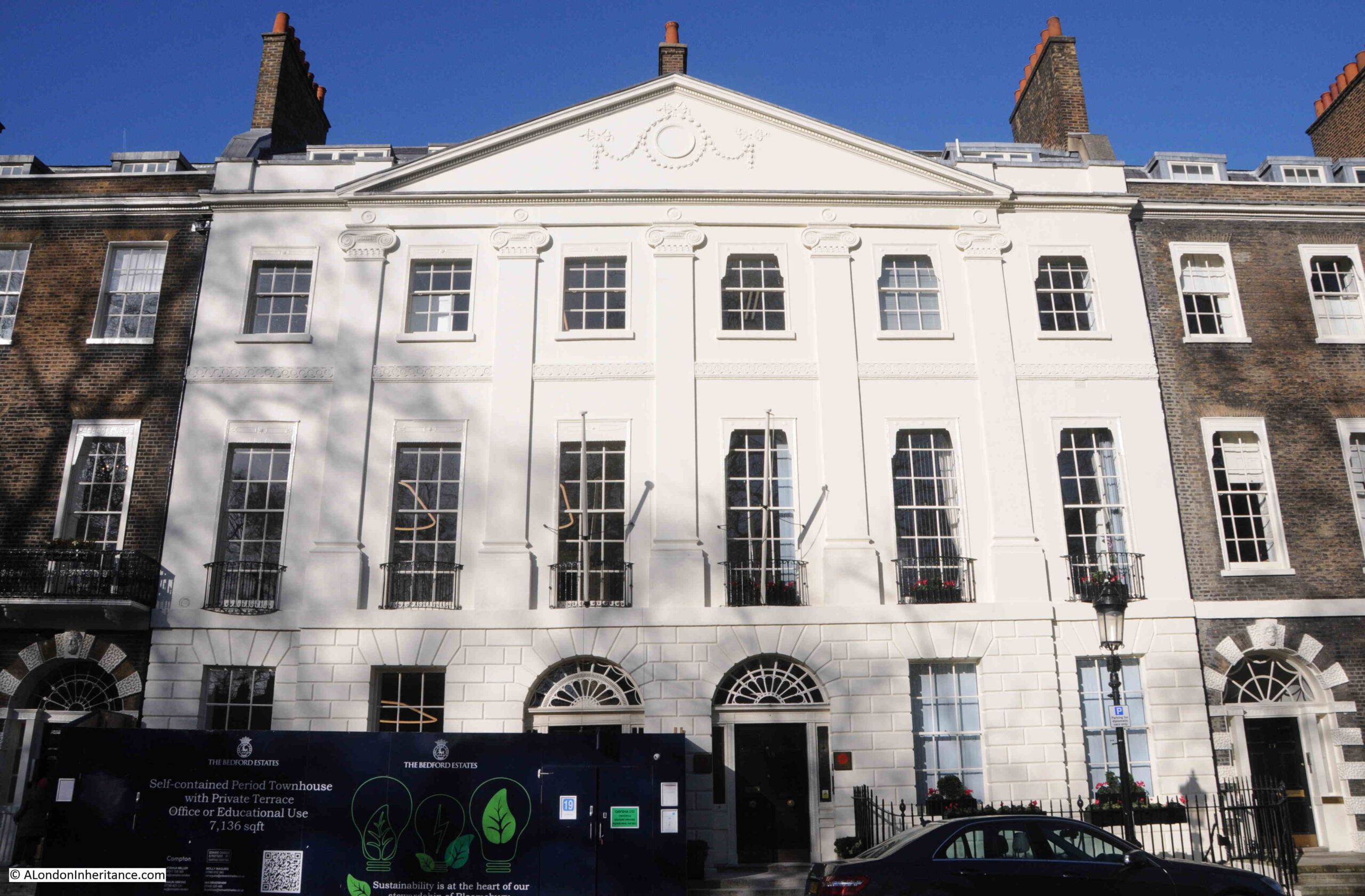
Whilst those in the centre of the other two sides, have five window bays, and a single entrance from the street:
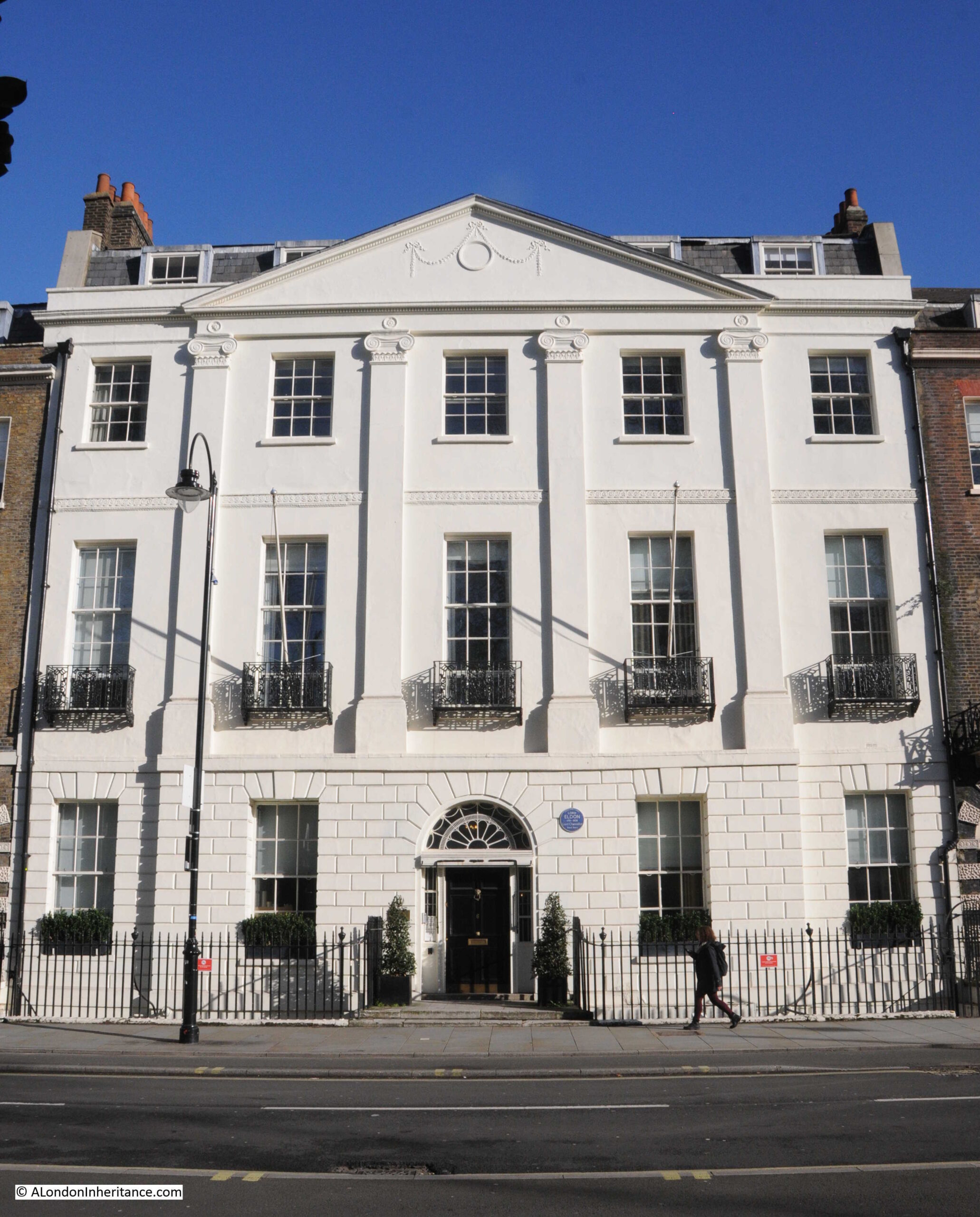
To the right of the entrance to the building in the above photo, a London County Coucil blue plaque record that Lord Eldon (1751 – 1838), Lord Chancellor, lived in the house.
He does not appear to have been very popular in the role of Lord Chancellor as the following is typical of the obituaries that were published after his death;
“For five-and-twenty years Lord Eldon held possession of the woolsack. Here was a position and a power of doing good in the hands of any man honestly disposed towards his country. For a quarter of a century he had absolute authority over the very stronghold of legal corruption – over the crying grievance of the nation – over the engine which broke the happiness, destroyed the fortunes, and wore away even the lives, of no small portion of his fellow men.
What did Lord Eldon do? Did he make one effort to palliate the evil? Did he, in a single instance, exert his power to rescue its victims? Did he, by one gesture, encourage those who were labouring day and night to work out the reformation he could at once have accomplished?
No. Lord Eldon was their bitterest, their most determined foe. He exerted his mighty power, in his court, in the cabinet, and in the closet, to stifle all enquiry, to destroy all opposition, to render hopeless every effort for amendment. He threw his protection over every harpy which fattened upon the corruption of his court, and verily they flourished.”
He also does not appear to have been that popular with his daughter, as she eloped with G S Repton, who was the son of Humphry Repton, the designer of the gardens in nearby Bloomsbury and Russell Squares.
View along the western side of Bedford Square:

The above photo shows that there are subtle differences to the apparent identical design of the houses in the terrace. Look at the decoration around the entrances, and the central two have solid white stone decoration, whilst the outer two have a mix of white Coade stone and the same brick as the rest of the house.
The central gardens are private, and are for the residents of the square.
As well as the majority of the surrounding houses being listed, these gardens are also Grade II* listed.
They have not changed that much since originally being set out. The shrubbery around the perimeter of the gardens appear to be a long standing feature. In the 19th century, paths across the grass were removed.
There was limited damage to the square during the last war, with a single house in the southern side of the square damaged, along with the houses in the south east corner.
The shrubbery limits the views across the gardens, but glimpses are available as shown in the following photo:

Another Bedford Square blue plaque on the house in the photo below:
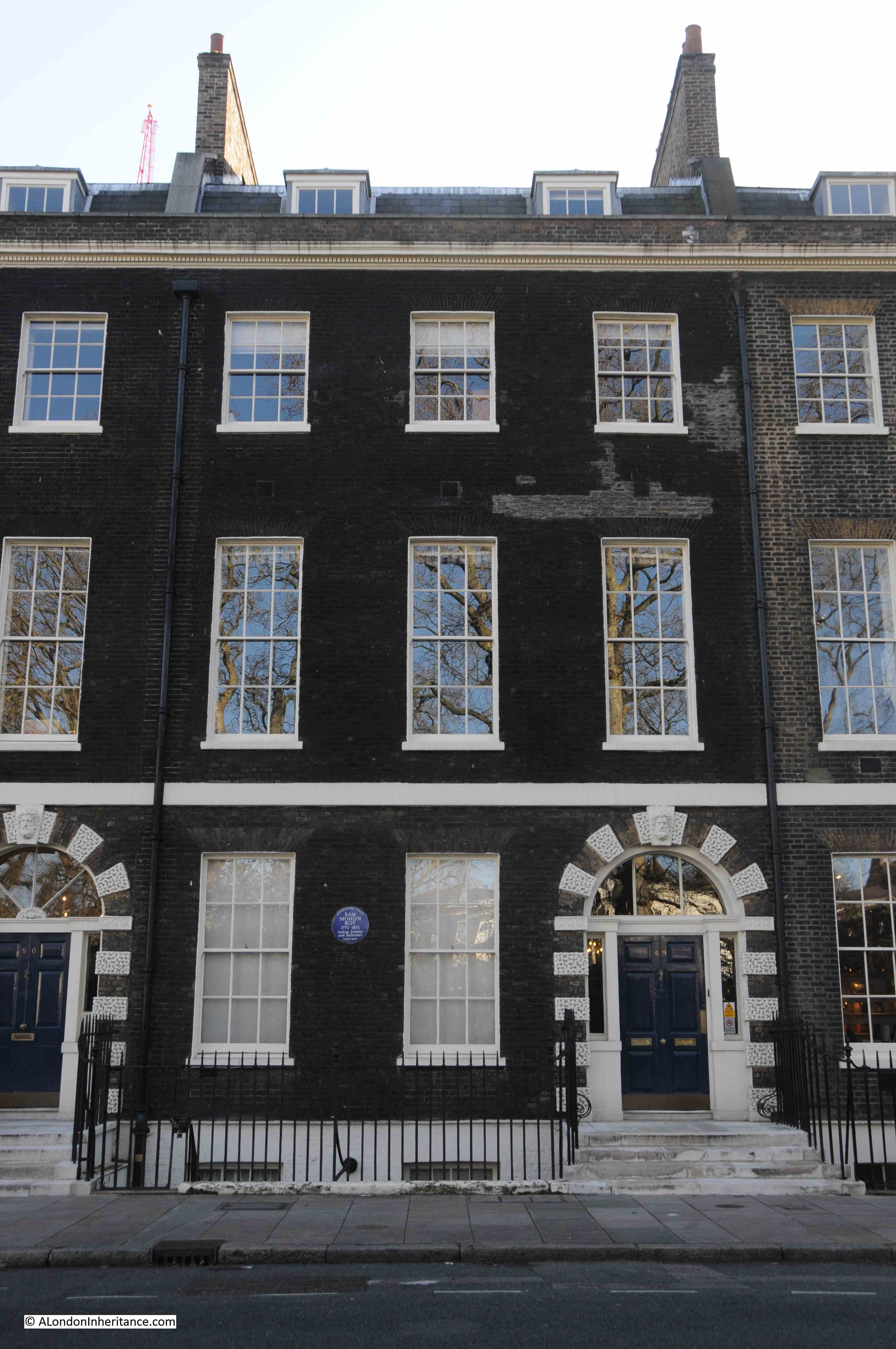
This plaque is a perfect example of the range and diversity of people who have passed through London over the centuries.
The plaque records that Ram Mohun Roy, Indian reformer and Scholar lived in the house.
Ram Mohun Roy was born in Radhanagar, Bengal, India, in 1772. Although a Hindu, Roy studied all the religions he could find in India. He wrote and campaigned against religious superstition, and the caste system.
He was the founder of two of India’s earliest newspapers, but after the British imposed censorship of the Calcutta press in the 1820s, he started to campaign for freedom of speech, and became more involved in social reform.
He had come into contact with the East India Company, working as a translator as well as an assistant to East India Company staff.
in 1830, Roy came to England. An ex-emperor of Delhi had made Roy his ambassador so that he could plead the emperor’s cause with the authorities of the East India Company.
He was well received in London society (no doubt a Bedford Square address helped), and addressed the Unitarians (a dissenting Christian approach, where members follow their own beliefs rather than the doctrine of the Church of England). The Unitarians are still based in Essex Street off the Strand, where their first meeting was held in 1774, so it was probably here that Roy made his address.
He did not return to India, but died in Bristol during a visit at the invitation of Unitarian friends, and is now buried at Arnos Vale cemetery in Bristol.
On an adjacent house is a green plaque:
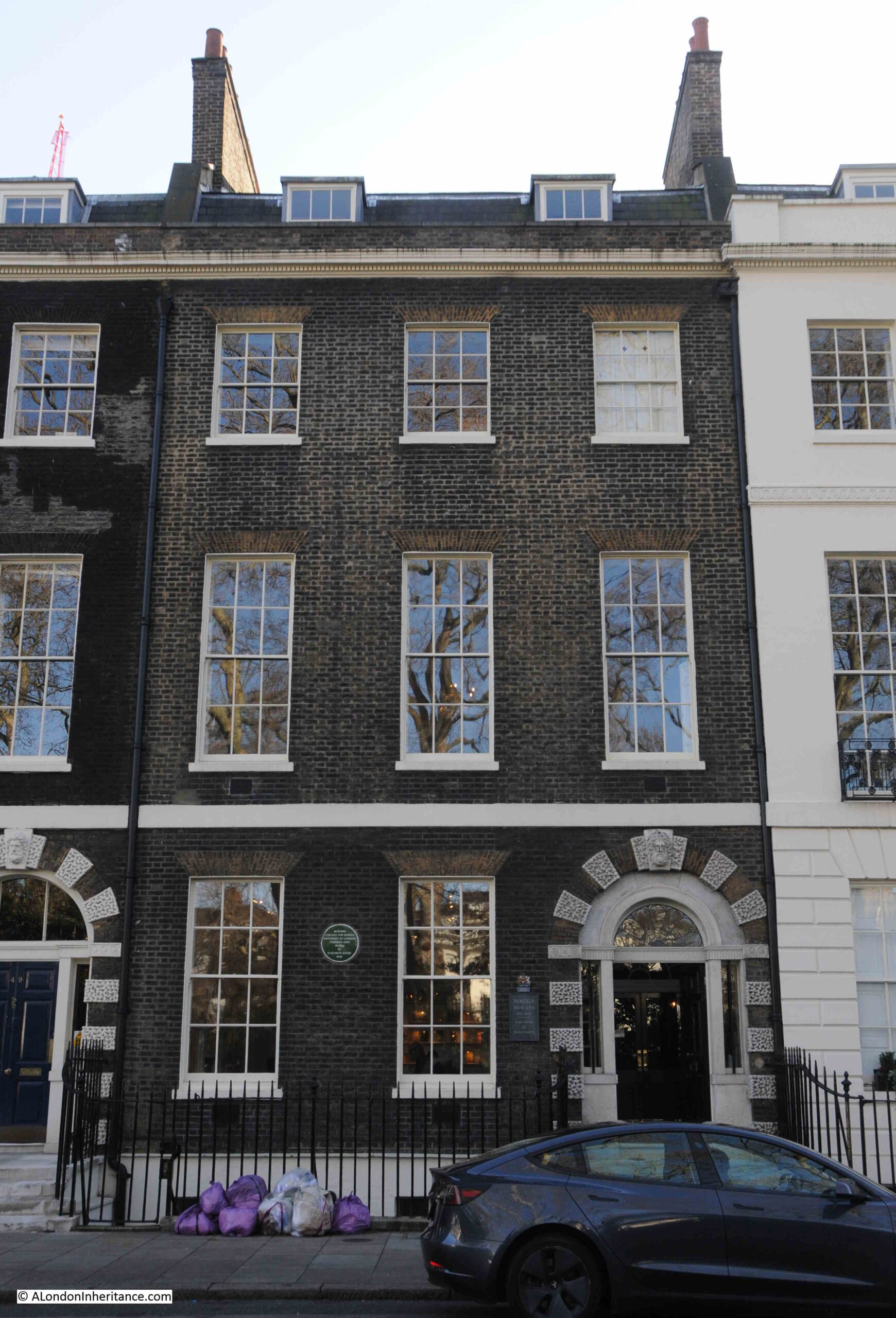
Recording that the Bedford College for Women, the University of London was founded in the house in 1849 by Elizabeth Jesser Reid.
There is a connection between Ram Mohun Roy and Elizabeth Jesser Reid, as she was the daughter of a wealthy Unitarian ironmonger and was born in 1789. She married Dr. John Reid, a nonconformist, and in 1849 she founded the Ladies College or College for Women, using her Unitarian and Bloomsbury connections to gather support, and to get teaching staff and professors to teach at the college.
The College was the first higher education establishment for women in the country.
It would stay in Bedford Square to 1874, when the lease came up for renewal. The Bedford Estate did not want to renew the lease with the college, so the college moved to larger premises near Baker Street.
Yet another blue plaque:
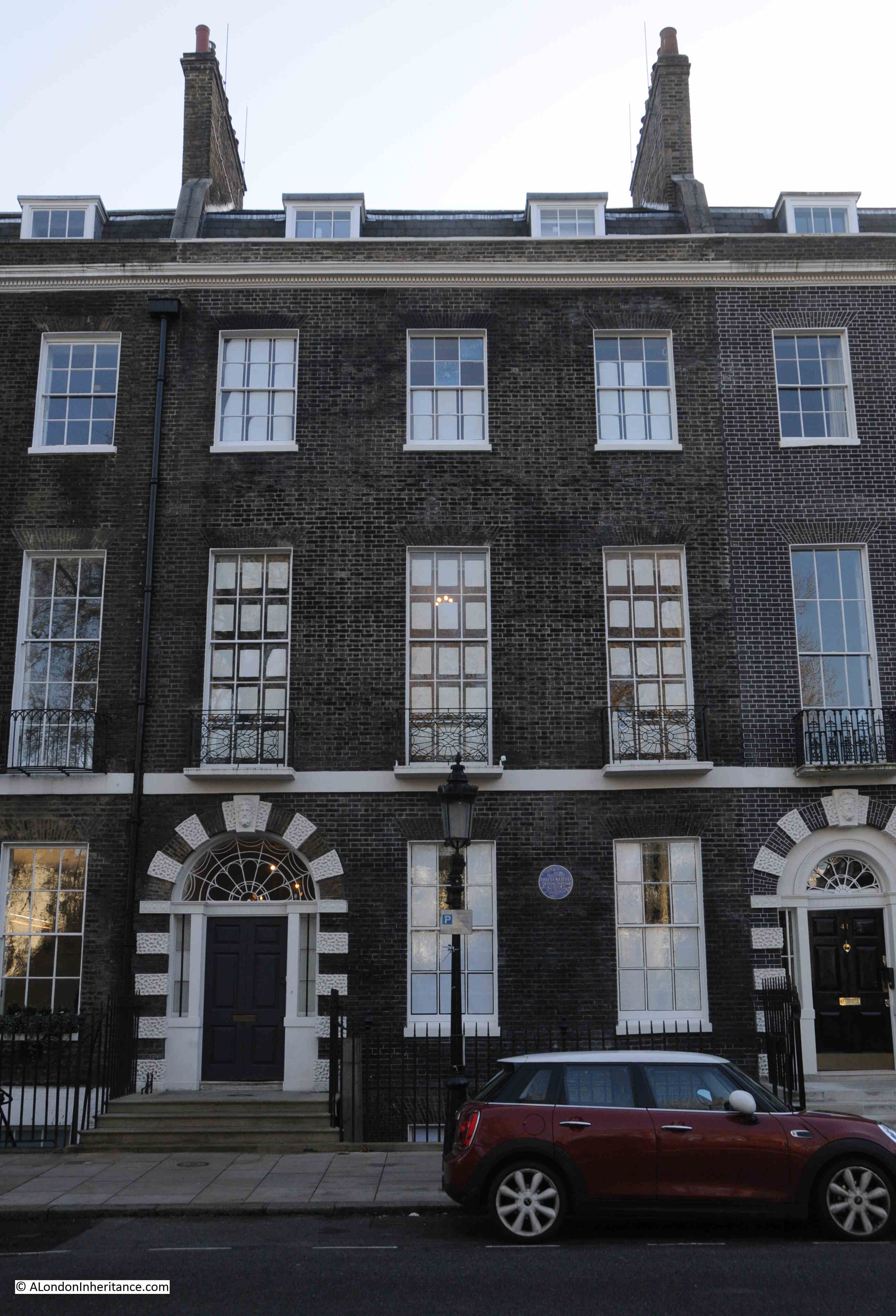
This one to an architect, William Butterfield.
Born in London in 1814, Butterfield trained as an architect and established his own architectural practice in Lincoln’s Inn Fields, before moving to the Adelphi.
He was involved with the study of Gothic Architecture, and the Victorian revival of religious architecture. This resulted in a considerable amount of work on churches and their associated building both in London and across the country.
William Butterfield died in his house in Bedford Square on the 23rd of February, 1900.
That is just a sample of the plaques to be found in Bedford Square.
Today, Bedford Square is home to a number of cultural institutions, including Sotheby’s Institute of Art, Yale University Press, and the New College for Humanities.
Bedford Square is one of those rare places in London, where, if you took away all the cars, a resident from the late 18th century, just after the square was completed, could return today and externally, the square would be perfectly recognisable.
It is also interesting to consider that whilst there is so much change across London, and there have been multiple different buildings on sites across much of London, when we stand in Bedford Square, we are looking at the only houses that have been built here, since the land was fields.
It is a lovely example of architecture and street planning.

Bedford Square has great examples of two of my favourite architectural features – vermiculated stonework and Flemish bond brickwork. If only architects and builders had the same vision of scale and presence today!
Thanks as ever for a great review. I bet you had an enjoyable day.
Thank you for this wonderful history of Bedford Square. So detailed and interesting. I will be sure to take a stroll round the square the next time I visit the British Museum.
The Architectural Association is situated on Bedford Square, perfect considering the buildings have remained the same!
I worked as an architect at Shankland Cox at No.13 (I think!) from 1972 -5 behind the first floor left hand window with the sun streaming in. Lovely time.
Im 70 now but as a 16 year old i had to attend an address in bedford square to sign my apprentiship papers as a plumber i belive if was the corner house on the west end of the south side
In the late 1960s I worked at Europa Publications based in 18 Bedford Square. I shared an office in the attics. A lift had been installed of the kind that had a metal grill gate and creaked its way slowly up and down. Many years later I was researching a number of West India merchants who had retired to Bedford Square in the late 18th and early 19th centuries so it was a familiar location. It’s a lovely square and the explanation of the leasing arrangements is fascinating.
I’d love to share some of this research
It seems more than a bit cheeky to be advertising myself, but if you click on my name you can access some of it via my website.
In the early 80’s I tempted for a solicitor who worked in one of the houses on the south side of the square. The building was beautiful inside, a lovely staircase and elegant hallway. It was a shame that it had been broken up into separate offices but the basic elegance remained.
Interesting to note that the square was not always held in such high regard. In the 1930s there was a serious proposal for the entire east side of the square to be pulled down to provide more space for the British Museum, even then short of space. There were no amenity societies as we know them at the time, only small local groups, and the Georgian Group had yet to be founded. SPAB did exist, but it was, as is clear from the name, for the protection of ‘ancient’ buildings — i.e. up to 1714, and there was no statutory listing system in place. Georgian building at the time was not thought to be important or ‘serious’. It was only after public outcry (lead by several people who would soon be involved with the founding of the Georgian Group), letters to the press and representations by people like the architect Erno Goldfinger, who had the lease at no. 7, on the east side of the square (and was quoted calling the developers as ‘Ignorant vandals’) that the BM backed down.
The square itself was, until relatively recently, accessible to anyone living in that part of Camden. Presentation of proof of address (to the Bedford Estate) and a deposit of £5 for a key bought access to the gardens for a year. ‘Relatively recently’ here means in the last 40 years or so. I believe the rules, and the fees, are now considerably different….
The Bedford Estate has a checkered reputation as steward of the area. As recently as 1979 the Estate was attempting to pull down the entire east side of Montague Street (on the other side of the BM, parallel to the east side of Bedford Square) to erect lovely 1960s style offfices. It was only the intervention of a then enlightened Camden Council and the DoE (equally enlightened) that saveed the buildings and helped to provide some 29 flats which are lived in to this day by many of the same people who moved in in 1981.
For anyone who would like to learn more about Bedford Square and neighbouring Gower Street after reading this excellent blog, I can heartily recommend local historian, Ricci de Freitas’, very comprehensive and lavishly illustrated book, ‘Lady Gertrude’s Legacy: Bloomsbury’s Bedford Square and Gower Street’, published by the Bloomsbury Association 2023.
Thanks for a very interesting article today. Your posts are always a welcome addition to my knowledge of London
John Diehl
Somewhat surprised that you didn’t mention the Architectural Association which has occupied many of the buildings on the west side of the square since 1917, and is the oldest school of architecture in the UK. The New College of the Humanities moved out of the square several years ago. It was acquired by Northeastern University (based in Boston) and is now located at St Katherine’s Docks by the Tower. On the south side of the square is Ecole Jeannine Manuel, a bilingual French school. In addition to its university publishing operation, Yale’s Paul Mellon Centre (which researches into British art and architecture) is also based in the square.
Also located on the square are a couple of diplomatic missions. The Turkish Republic of Northern Cyprus has its representative at 26 (north west corner), the Angolan embassy is at 46 (middle of the south side), and the Hong Kong Trade Mission is at number 18.
Among the residents, Lady Ottoline Morell lived at number 44 – she was a member of the Bloomsbury Group, and was notorious for her many lovers, including Axel Munthe, Bertrand Russell, Augustus John, Henry Lamb, Dora Carrington, and Roger Fry. She had an affair with her gardener Lionel Gomme, and an affair with a stonemason (“Tiger”) who carved plinths for statues in the garden of her country house was said to be the inspiration for Lady Chatterly’s Lover.
Another excellent pièce of work with some great photographs. Thank you. I was reminded by the Rocques map, that the next building along after Montagu House to the east shows Bedford House and their garden which then faced open fields and what is now Russell Square, has two very interesting shapes on the north east and west corners. These represent the civil war fortifications and are residual shapes of what were probably positions for gun batteries. Some of the trees of that garden might remain.
I always look forward on Sundays for your pieces. Thanks once again.
Thank you for a fascinating stroll around Bedford Square. It is a square very familiar to me as when I was first in London in 1975 I lodged in Gower St. My work place was at the same latitude as Bedford Square but in Tottenham Court Road.
More latterly I strolled around it taking in all the plaques with my daughter during lockdown and even more recently have parked there often visiting my wife in the nearby Macmillan in Huntley Street.
Next time I am there I will enjoy its presence all the more.
Hello! I’m not replying to this post specifically but am not sure how else to get in contact with you. I’ve been devoted to your weekend posts for many years – they are so brilliant. I wonder if you’ve ever done a post on the glass ‘tunnels’ that connected front doors to the street in the Paddington area, presumably to keep posh visitors dry as they alighted their hansom cabs? You can still see them in Orsett Terrace, though the war wiped a lot of them out. I’m curious because I’m helping republish a wonderful lost children’s book from 1950 – Caterpillar Hall by Anne Barrett – set in the area. I’d love to know their origins – if in fact it is known. With thanks and all best wishes … Jon